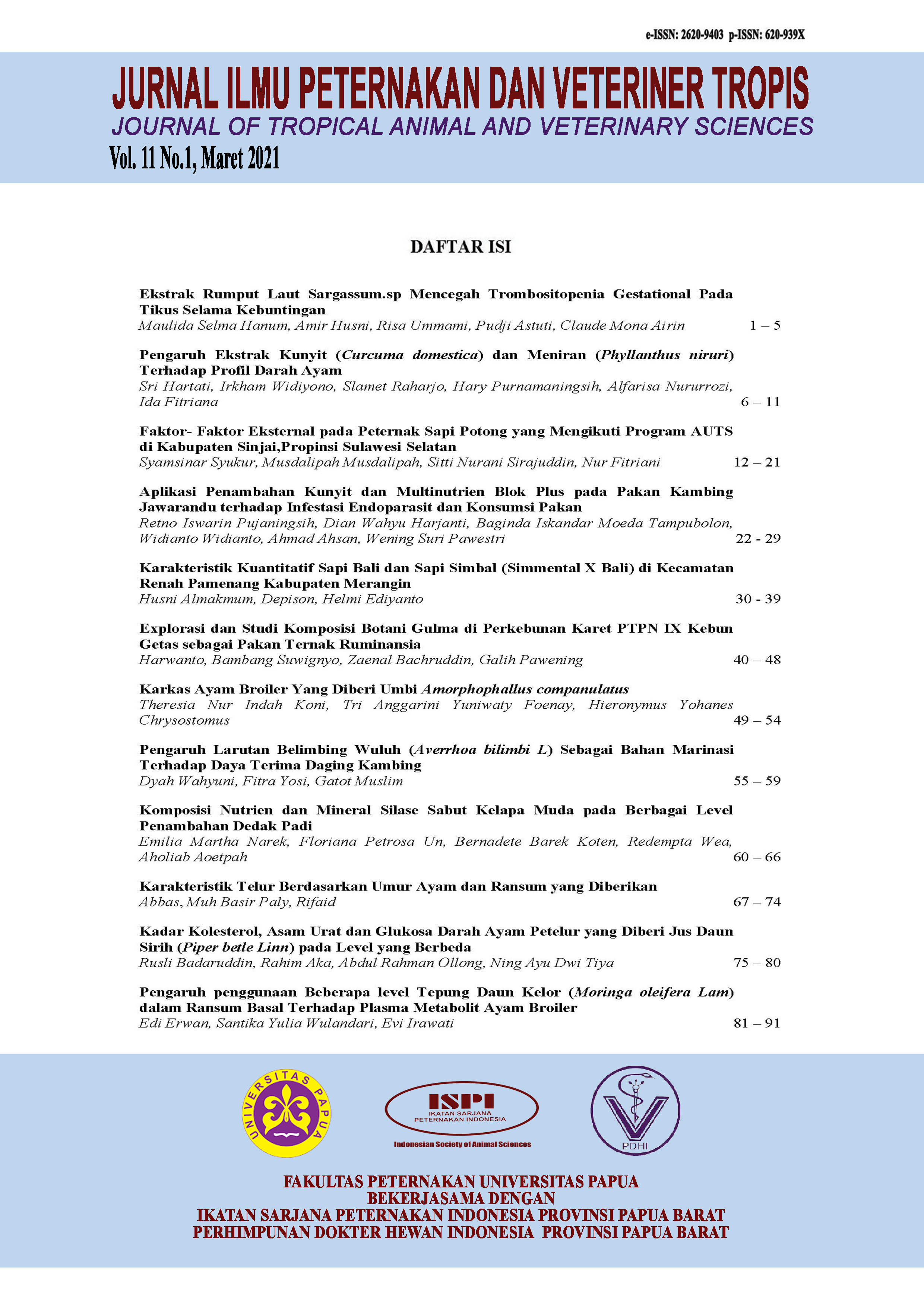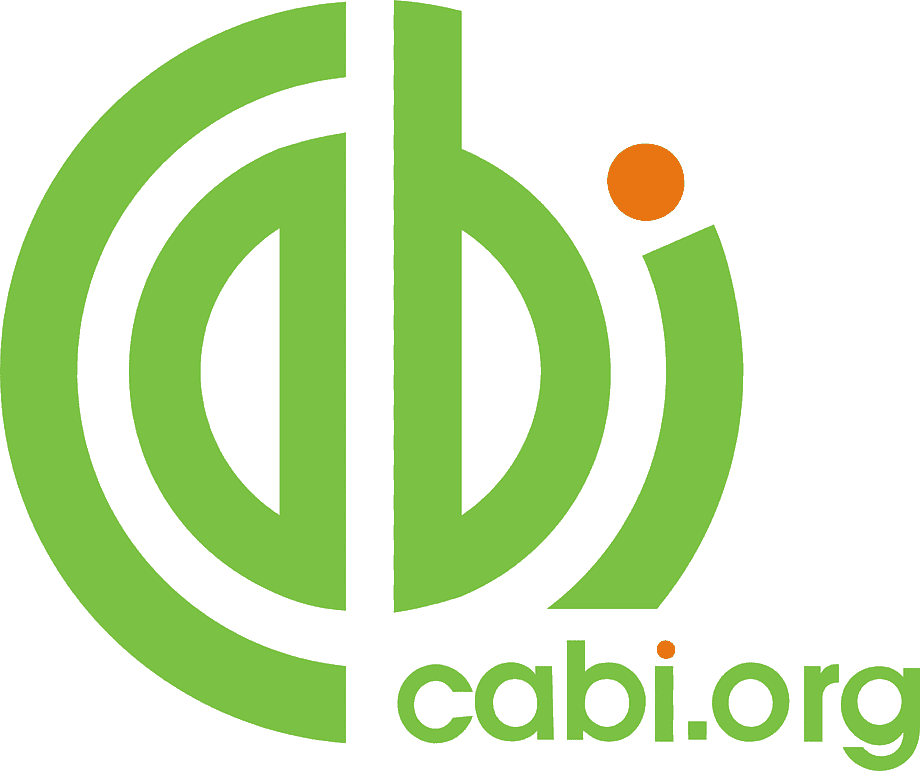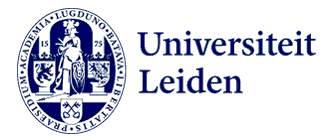Aplikasi Penambahan Kunyit dan Multinutrien Blok Plus pada Pakan Kambing Jawarandu terhadap Infestasi Endoparasit dan Konsumsi Pakan
Application Of Turmic Addition And Multinutrient Block Plus On The Jawarandu Goat’s Diet Towards Endoparasit Infestations And Feed Consumption
DOI:
https://doi.org/10.46549/jipvet.v11i1.128Keywords:
turmeric, Multinutrient blocks, Jawarandu goats, endoparasite, feed intakeAbstract
Goat management in rural areas is still commonly done traditionally with little regard for health factors. One factor is the presence of parasitic worms in the goat's digestive tract which causes disturbed growth. The research aims to evaluate the effect of the addition of turmeric and multinutrient block plus (MNBP) in eliminating endoparasites and increasing feed intake of Jawarandu goats. The material used was 12 male Jawarandu goats weighing an average of 20 kg. A completely randomized design was used in this study with 4 treatments and 3 replications. Treatment T0: basal ration + MNBP; T1: T0 + 1% turmeric; T2: T0 + 3% turmeric; T3: T0 + 5% turmeric. The parameters observed were feed intake, weight gain, number of endoparasites and total eggs per gram of feces. Data analysis using analysis of variance significance level of 5% to determine the effect of treatment. If there is a treatment effect, it is followed by Duncan's multiple range test. The results showed a decrease in the number of endoparasites. The best treatment to induce an antibody system is T2 treatment, namely the addition of turmeric with a level of 3%. Feed intake was not significantly increasing although improving body weight gain in T2 and T3. The conclusion of the study is that the administration of MNBP and turmeric with a level of 5% has not been able to eliminate all endoparasites until the 28th day. MNBP and turmeric are useful as natural antioxidants. Increased level of turmeric can increase weight gain and immune system of goats.
Keyword: Multinutrient blocks, turmeric, Jawarandu goats, endoparasite, feed intake
Downloads
References
Ekawasti F, Suhardono DA, Dewi E, Martindah AH, Wardhana dan DH Sawitri. 2019. Skrining Efektivitas Ekstrak Tanaman Herbal sebagai Anthelmintik terhadap Telur dan Larva Nematoda serta Cacing Haemonchus contortus secara In Vitro. Prosiding. Seminar Nasional Teknologi Peternakan dan Veteriner 2019. DOI: http://dx.doi.org/10.14334/Pros.Semnas.TPV-2019-p.462-473
Fardana DH, BIM Tampoebolon, E Pangestu, Widiyanto dan RI Pujaningsih. 2019. Evaluasi pemberian pakan dengan jumlah multinutrien blok yang berbeda sebagai suplemen terhadap performans kambing kacang. J. Litbang Provinsi Jawa Tengah. 1 (17): 88-99
Firsoni dan D Ansori. 2015. Manfaat Urea Molasses Multinutrient Blok (UMMB) yang Mengandung Tepung Daun Glirisidia (Gliricidia sepium) secara In-vitro. Jurnal Ilmiah Aplikasi Isotop dan Radiasi 11(02): 161-170.
Fisdiora Z, U Balqis dan M Hambal. 2018. Pengaruh ekstrak kunyit (Curcuma domestica) konsentrasi 75% terhadap motilitas dan mortilitas cacing Ascaridia galli secara in vitro. J. Ilmiah Mahasiswa Veteriner. 2 (1): 86-93.
Hayakawa HY, Minanyia K Ito, Y Yamamoto, and T Fukuda. 2011. “Difference of curcumin content in Curcuma longa L., (Zingiberaceae) caused by Hybridization with other Curcuma species,†Journal American of Plant Sciences. 2 (2). 111–119.
Kearl LC. 1982. Nutrient Requirement of Ruminant in Developing Countries. International Fedstuffs Institute, Utah Agriculture Experiment Stations, Utah State University, Logan Utah.
Kusbiantoro D dan Y Purwaningrum 2018. Pemanfaatan kandungan metabolit sekunder pada tanaman kunyit dalam mendukung peningkatan pendapatan masyarakat. J. Kultivasi. 17 (1): 543-549 .
McAnulty R and T Cook. 2019. Wormwise: National Worm Management Strategy. Wormwise, Wellington.
Mulyadi T. 2018. Prevalensi Cacing Saluran Pencernaan pada Kambing Peranakan Etawa (PE) di Kelompok Tani Kecamatan Gedong Tataan Kabupaten Pesawaran Lampung. Fakultas Pertanian, Universitas Lampung, Bandar Lampung. (Skripsi).
Nurtjahyani SD dan DS Agustin. 2014. Prevalensi infeksi telur cacing nematode pada feses sapi potong (Boss p) dengan metode whitlock. Prosiding Seminar Nasional XI Biologi, Sains, Lingkungan dan Pembelajarannya. Surakarta, 7 Juni 2014. Fakultas Keguruan dan Ilmu Pendidikan Universitas Sebelas Maret, Surakarta. 539-543.
Oktofani LA dan JF Suwandi. 2019. Potensi tanaman pepaya (Carica pepaya) sebagai antihelmintil. J. Majority. 8 (1): 246-250.
Pangestika D, E Mirani dan ID Mashoedi. 2012. Pengaruh pemberian mumnyit (Curcuma domestica Val.) terhadap aktivitas fagositosis makrofag pada mencit BALB/C yang diinokulasi bakteri Listeria monocytogenes. J. Sains Medika. 4 (1): 63-70.
Prasetiadi RD, Heriyadi dan Y Yurmiati. 2017. Performa domba lokal jantan yang diberikan tambahan tepung kunyit (Curcuma Domestica Val.). J. Ilmiah Ternak.17(1): 52 – 58.
Primawati SN, R Sucilestari dan L Zainiati. 2014. Pengaruh kurkumin kunyit putih (Curcuma zedoaria) terhadap keberadaan koloni bakteri pada limpa mencit yang diinfeksi Salmonella typhimurium. J. Ilmiah Biologi Bioscientist. 2 (1): 84-87.
Pujaningsih RI, BIM Tampoebolon, Widiyanto dan DW Harjanti. 2018. Evaluation of the effectiveness of the use of pepaya fruit latex in making herbal medicated multinutrition block as a local goat feed supplement. J. Animal Production. 20 (1): 39-44.
Qurniawan A. 2016. Kualitas daging dan performa ayam broiler di kendang terbuka pada ketinggian tempat pemeliharaan yang berbeda di Kabupaten Takalar Sulawesi Selatan. Tesis. Program Pascasarjana, Institut Pertanian Bogor. Bogor.
Rozi F, J Handoko dan R Febriyanti. 2015. Infestasi cacing hati (Fasciola sp.) dan cacing lambung (Paramphistomum sp.) pada sapi Bali dewasa do Kecamatan Tenayan raya Kota Pekanbaru. J. Sain Veteriner. 33 (1): 8-15.
Sari LORK. 2006. Pemanfaatan Obat Ttadisional dengan Pertimbangan Manfaat dan Keamanannya. Majalah Ilmu Kefarmasian, Vol. III, No.1, pp. 01 - 07. doi:10.7454/psr.v3i1.3394.
Singh S, AK. Pathak, M. Khan and R.K. Sharma. 2015. Multi-nutrient blocks with and without tanniferous leaf meal mixture: formulation and preparation under sub-tropical environment of jammu. J. Animal Research. 5 (1): 7-14.
Suharyono. 2014. Pengembangan suplemen pakan urea molases multi-nutrien blok (UMMB) menggunakan sumber protein tepung kedelai dan gliricidia sepium (Gs) untuk ternak ruminansia. J. Ilmiah aplikasi isotop dan radiasi. 10 (1) : 11-21.
WHO. 2003. Traditional medicine, http://www.who.int/mediacentre/factsheets/fs134/en/, diakses Juni 2020.
Widiarso BP dan Wida WM. 2019. Respon Peternak terhadap Pencegahan dan Pengobatan Penyakit Cacing Gastrointestinal pada Kambing di Desa Klopo Kecamatan Tegalrejo Kabupaten Magelang. Jurnal Ilmu Peternakan dan Veteriner Tropis. 9 (2) : 76-82. DOI: https://doi.org/10.30862/jipvet.v9i2.68
Wulandari E. 2019. Uji Mikrobiologis Salmonella, Water Activity dan Total Bakteri Multi nutrien Blok Kombinasi Cangkang Kerang dan Cangkang Telur sebagai Sumber Mineral. Fakultas Peternakan dan Pertanian Universitas Diponegoro, Semarang. (Skripsi).
Zingare S, K Pajai, S Waghmare, MFMF Siddiqu, S Kuralkar, S Hajare and V Wankhade. 2018. Anthelmintic evaluation of Carica pepaya against gastrointestinal helminths of goats. J. Pharmacognosy and Phytochemistry. 7 (6): 1746-1748.
Downloads
Published
How to Cite
Issue
Section
License
License and Copyright Agreement
In submitting the manuscript to the journal, the authors certify that:
- They are authorized by their co-authors to enter into these arrangements.
- The work described has not been formally published before, except in the form of an abstract or as part of a published lecture, review, thesis, or overlay journal. Please also carefully read Jurnal Ilmu Peternakan dan Veteriner Tropis (Journal of Tropical Animal and Veterinary Science) Posting Your Article Policy at https://journal.fapetunipa.ac.id/index.php/JIPVET/publicationethics
- That it is not under consideration for publication elsewhere,
- That its publication has been approved by all the author(s) and by the responsible authorities “tacitly or explicitly“ of the institutes where the work has been carried out.
- They secure the right to reproduce any material that has already been published or copyrighted elsewhere.
- They agree to the following license and copyright agreement.
Copyright
Authors who publish with Jurnal Ilmu Peternakan dan Veteriner Tropis (Journal of Tropical Animal and Veterinary Science) agree to the following terms:
- Authors retain copyright and grant the journal right of first publication with the work simultaneously licensed under a Creative Commons Attribution License (CC BY-NC-SA 4.0) that allows others to share the work with an acknowledgment of the work's authorship and initial publication in this journal.
- Authors are able to enter into separate, additional contractual arrangements for the non-exclusive distribution of the journal's published version of the work (e.g., post it to an institutional repository or publish it in a book), with an acknowledgment of its initial publication in this journal.
- Authors are permitted and encouraged to post their work online (e.g., in institutional repositories or on their website) prior to and during the submission process, as it can lead to productive exchanges, as well as earlier and greater citation of published work.

This work is licensed under a Creative Commons Attribution-NonCommercial-ShareAlike 4.0 International License.





























.png)
